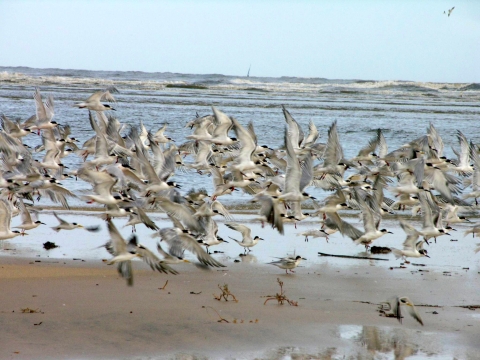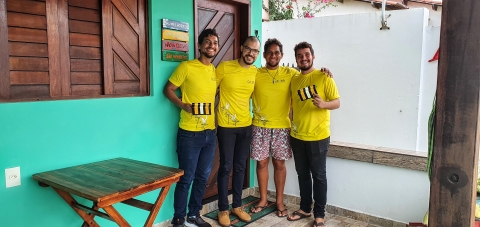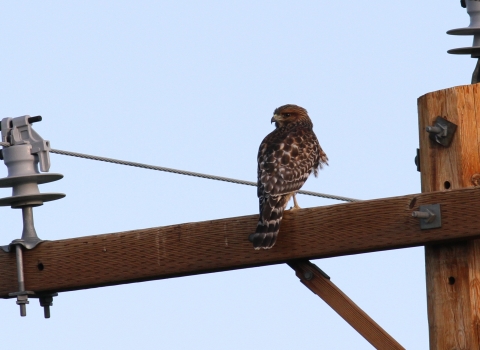Helen Hays, longtime researcher on New York’s Great Gull Island, was the first to get word that roseate and common terns were turning up dead under power lines near the coastal village of Galinhos, on Brazil’s eastern tip.
Her response set in motion a chain of events that would unite biologists from the northern and southern hemispheres, in support of an endangered seabird that weighs little more than a deck of cards and migrates thousands of miles each year.
The Service and our partners have been dedicated to the study of roseate terns for decades. Supported by the Endangered Species Act, which turns 50 this year, our innovative work has informed management actions across the northeastern U.S. Until recently, however, we knew little about their health and safety when they aren’t in our care, during their long commutes and months spent far afield.
Thanks to skilled, local observers in Brazil and the long-term relationships we’ve nurtured in North America, however, that is changing.
Crucial coordination
Every May, roseate terns arrive on coastal islands like Bird and Ram in Massachusetts and Great Gull in New York, which together host 90% of the Northeast’s breeding population. Researchers work to ensure these seabirds have the conditions they need to raise chicks to fledging before returning to northern Brazil in September.
Until her retirement in 2023, Susi von Oettingen was national recovery coordinator for roseate terns at our New England Field Office in New Hampshire. She chaired the Roseate Tern Recovery Working Group, made up of American, Canadian, British and Brazilian tern researchers in the federal, state, provincial, nonprofit and academic arenas. The group meets annually to share research findings and field-season reports and to view the status of the species holistically.
“The working group is critical to roseate tern recovery,” said von Oettingen. “We identify potential threats and develop strategies to address them. The different entities support each other and work together to implement recovery strategies.”
In 2019, when they learned roseates were dying on Brazilian beaches, this tight-knit band of scientists sprang into action.
A call for help
Following the startup of a nearby onshore wind facility in 2014, volunteer monitors from Centro de Estudos e Monitoramento Ambiental (CEMAM), a local nonprofit that surveys the beach in Galinhos for stranded marine wildlife affected by offshore oil drilling, noticed an uptick in dead terns near some power lines. In 2017 alone, they found the bodies of 110 roseate terns.
While in Galinhos, the terns forage at sea by day and roost in commercial salt evaporation ponds behind the power transmission lines at night. Terns can fly up to 25 miles per hour; at that speed, one wrong move can result in a deadly collision. Leading up to the spring migration north, large numbers of roseate terns gather in the area.
The monitors traced the dead birds’ origins through leg bands they’d received as chicks on Great Gull, Ram and Bird islands. That’s how they tracked down Hayes.
Hayes relayed news of the tern deaths to Joan Walsh, Gerard Bertrand Chair of Field Ornithology & Natural History with Mass Audubon. Walsh had a history with these birds, having studied terns on Great Gull Island as an undergraduate student in the early 1980s. Her work now includes international bird conservation.
Walsh travelled to Galinhos in winter 2018, where she met with the CEMAM monitors.
“They showed me 140 birds that they’d saved in a freezer,” she said. “It’s chilling, when your life’s work is nursing every tern chick to fledging, to see what is essentially the largest known kill of roseate terns.”
Researchers working with nesting terns in North America consider habitat loss, food scarcity and predation their greatest threats. The dangers are different in nonbreeding areas, however, and more likely to affect adult birds.
Each roseate tern pair produces, on average, one chick a year, and only about one in three chicks survives to breeding age. Once they reach adulthood, however, roseate terns can live, and reproduce, for many more years. While the Northeastern population of roseate terns has stabilized in recent years, large losses of adult birds on their wintering grounds would take a toll before long.
Walsh presented her alarming findings to colleagues at the 2019 Roseate Tern Recovery Meeting, and von Oettingen applied for a State of the Birds grant from the Service to investigate the situation. Mass Audubon and our Migratory Bird Program received $104,000 in 2022 to study reducing tern collisions with power lines and the birds’ interactions with the lines and nearby wind farm.
Crowdsourcing a solution
Walsh knew just where to go for expertise on reducing utility-related bird deaths.
“There's a school of conservation built around collisions with power lines,” she said. “We’re an energy-hungry country, and that’s how we move energy.”
She reached out to the Avian Power Line Interaction Committee, an association of utility companies, wildlife resource agencies, conservation groups and manufacturers that works to reduce bird injuries, and the related power outages, caused by collisions with utility lines. They recommended working with Power Line Sentry — a Colorado company that designs and sells Hawk Eye Bird Flight Diverter markers — to design and produce custom line markers for the study.
Von Oettingen recruited Manuela Huso, research statistician emerita with the U.S. Geological Survey’s Forest and Rangeland Ecosystem Science Center in Corvallis, Oregon, to design a scientifically sound study to test the line markers. Huso recommended comparing the utility industry’s standard marker spacing with a more concentrated arrangement.
Using data about dead birds collected by the CEMAM monitors — date, time, location, condition — the team designed line markers and a layout they hoped would reduce or avoid tern mortality. To provide 24-hour visibility, the markers have two types of tape — one that reflects sunlight and another that absorbs solar energy by day and glows at night.
Power Line Sentry worked with the power company in Galinhos to install the markers, which it also helped fund, in December 2021. Monitors with CEMAM, along with graduate students from nearby State University of Rio Grande do Norte, surveyed for terns from January to March 2022. They found only nine dead roseate terns, far fewer than previous years. Most mortalities happened on a single night of high winds.
Surveys resumed in 2023, using funding from Environment and Climate Change Canada. Monitors found 17 dead roseate terns, a substantial reduction from a few years earlier but higher than researchers had hoped for. The team plans to analyze weather data, exact collision locations and marker layout to refine their methods.
Tailing terns
Meanwhile, to assess tern movements relative to the power lines in Galinhos, and nearby industrial activities, Pam Loring, wildlife biologist with our Migratory Birds program in the Northeast Region, designed a study using satellite transmitters to map the terns’ flights between their onshore roosting and offshore feeding areas.
In February and March 2022, researchers placed transmitters on 12 roseate terns and three common terns and tracked their activity using satellites. During the day, terns used offshore areas targeted for petroleum production facilities and wind energy development. At night, they flew near the power lines, shrimp aquaculture ponds, salt evaporation ponds and onshore wind farms.
“The study provides new information on movements and exposure of terns to onshore and offshore risks throughout their daily cycle,” said Loring. “Results will inform risk assessments and conservation plans, and guide future research.”
Because terns are tiny, they can’t carry much weight, limiting the options for tracking their movements with precision. The team hopes to use a combination of methods — such as radar, cameras and GPS tags — to collect more detailed data about the terns’ flight paths and altitudes near the power lines and other collision hazards. They also aim to create a GIS-mapping tool — using data on energy infrastructure and habitat types — to support tern conservation across a larger area of the South American coast.
Identity verification
During the breeding season, when terns nest along the northeastern coast of North America, adult roseate terns and common terns are relatively easy to tell apart. When the two species are in Brazil and no longer in breeding plumage, however, the task is harder.
David Sibley, author and illustrator of numerous bird identification books, created a guide to help beach monitors in Brazil verify by sight which species they find.
And even though all roseate terns look the same, there are two distinct North-Atlantic populations — endangered Northeastern and threatened Caribbean. They rarely mingle on breeding grounds but most likely mix when in Brazil.
Anticipating the discovery of genetic differences between the two, monitors took tissue samples from dead roseate terns. Researchers at the Smithsonian Zoo will study the specimens, looking for variations in their DNA.
Consequential connections
Conservation requires connection — between people and nature, sure, but also between Tribes, federal agencies, state and local governments, conservation organizations and private citizens. The future of the Endangered Species Act relies on these collaborations. Together, we're developing innovative solutions to challenges like minimizing the effects of new energy technologies on our most vulnerable species.
In 2022, the Galinhos team got a tip from a community member about another site where terns have collided with power lines. They discovered rufa red knots, shorebirds listed as threatened under the Endangered Species Act, have also died there. This was valuable information for the North American researchers, who weren’t aware red knots — which stop in Delaware Bay to feed and rest during their spring migrations to the Arctic — were using the location during the nonbreeding season.
As a result of the work in Galinhos, Brazilian researchers formed an offshore-wind working group, which has since reported serious concerns about the activity’s effects on terns. Facilities can be built within five kilometers — a little more than three miles — of the Brazilian coast, jeopardizing foraging terns.
Conservation here and there
To a person, the American researchers expressed appreciation for their Brazilian teammates and a sense of accomplishment from helping the terns while they’re abroad.
“It’s very difficult to do full-life cycle conservation, but things just seemed to fall in place with this project,” said Walsh. “It’s the most important and rewarding work I’ve done in 40-plus years of working with birds.”
Thanks to communication across the miles — thousands of them — and expertise in two places, roseate terns are getting the help they need.










